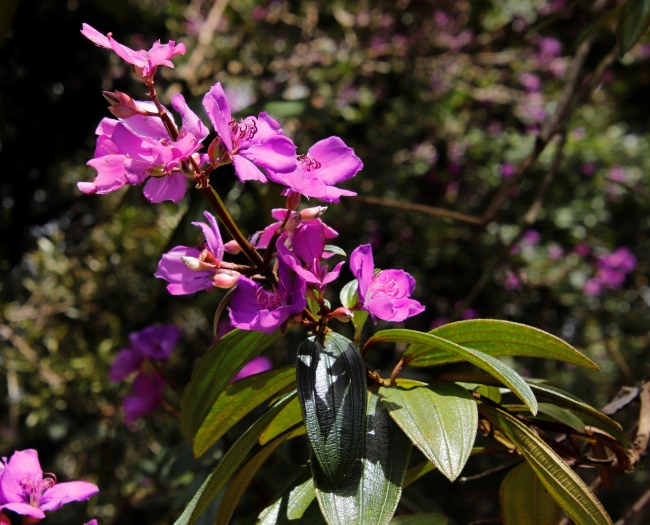Purple Glory Tree
(Pleroma granulosum)
Purple Glory Tree (Pleroma granulosum)
/
/

© Tony Rebelo
CC BY-SA 4.0
Image By:
© Tony Rebelo
Recorded By:
Copyright:
CC BY-SA 4.0
Copyright Notice:
Photo by: © Tony Rebelo | License Type: CC BY-SA 4.0 | License URL: http://creativecommons.org/licenses/by-sa/4.0/ | Uploader: tonyrebelo | Publisher: iNaturalist |

























Estimated Native Range
Summary
Pleroma granulosum, commonly known as Purple Glory Tree or Princess Flower, is a deciduous tree native to Bolivia and the Atlantic forest regions of Brazil. It can grow up to 33 feet (10 meters) tall and wide, with a rounded canopy of dense, velvety foliage. The leaves are dark green and covered with a fine down, which adds to the plant’s tactile interest. The Purple Glory Tree is renowned for its profuse, vibrant purple flowers that bloom throughout the year in its native habitat, with peak flowering in late winter to early spring. The blooms are large, showy, and attract pollinators such as bees and butterflies.
In cultivation, Pleroma granulosum is valued for its continuous flowering habit and striking floral display, making it a popular ornamental tree in tropical and subtropical gardens. It is often used in urban landscaping, as a specimen tree, and for lining streets. This species prefers well-drained, acidic soils and thrives in full to partial sun. While it requires average water, it is somewhat drought-tolerant once established. It is sensitive to frost and should be protected from freezing temperatures. In USDA zones 10b to 11, it can endure short cold spells but may suffer from reduced blooming as it recovers. Gardeners should be aware that it can become invasive in some tropical areas outside its native range, so monitoring and control may be necessary.CC BY-SA 4.0
In cultivation, Pleroma granulosum is valued for its continuous flowering habit and striking floral display, making it a popular ornamental tree in tropical and subtropical gardens. It is often used in urban landscaping, as a specimen tree, and for lining streets. This species prefers well-drained, acidic soils and thrives in full to partial sun. While it requires average water, it is somewhat drought-tolerant once established. It is sensitive to frost and should be protected from freezing temperatures. In USDA zones 10b to 11, it can endure short cold spells but may suffer from reduced blooming as it recovers. Gardeners should be aware that it can become invasive in some tropical areas outside its native range, so monitoring and control may be necessary.CC BY-SA 4.0
Plant Description
- Plant Type: Shrubs, Trees
- Height: 12-24 feet
- Width: 6-12 feet
- Growth Rate: Moderate
- Flower Color: Purple
- Flowering Season: Summer
- Leaf Retention: Evergreen
Growth Requirements
- Sun: Full Sun, Part Shade
- Water: Medium
- Drainage: Medium
Common Uses
Bird Garden, Butterfly Garden, Hummingbird Garden, Low Maintenance, Potted Plant, Showy Flowers
Natural Habitat
Native to the cerrado and Atlantic forest regions of Brazil
Other Names
Common Names:
Scientific Names: Pleroma granulosum , Antheryta granulosa , Lasiandra fontanesiana , Lasiandra fontanesiana var. angustior , Lasiandra fontanesiana var. major , Melastoma fontanesii , Melastoma granulosum , Rhexia alata , Rhexia dasystaminea , Rhexia dasystaminea
GBIF Accepted Name: